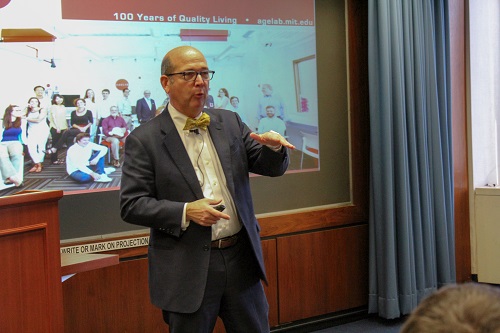Transportation in a World That Is Gray, Delayed, Small, and Female
Demography is destiny, according to Joseph Coughlin, founder of the Massachusetts Institute of Technology AgeLab.
Put another way, who we are today will determine the society we live in tomorrow.
And today, we are increasingly older. Half of children born in 2007 have a chance of living to age 100. People over eighty-five represent the fastest-growing demographic group. For politics, policy, and technology, the new demand is that people will live longer, and better, than past generations.
“As transportation professionals, we know that before you do anything, you’ve got to get there first,” Coughlin said recently as part of the U.S. DOT Volpe Center’s speaker series, The Ongoing Transformation of the Global Transportation System. “I think you’re going to start to see transportation rise in the agenda to a higher level than we’ve ever seen before, in part because of an aging population.”
A World That Is Gray
As education and income go up, birth rates drop. Falling birth rates in many countries, coupled with longer lifespans, means a population that is older—and, as far as hair color is concerned, grayer.
“2047 is the year I want you to think about,” Coughlin said. “2047 is the year that worldwide, we’ll have more people over the age of 60 than we’ll have children between 0 and 15. Think about how this might change demand, lifespans, activities, and the like.”
Older populations will have come of age in an era of high expectations. They will be used to their needs and their wants being met. They will be highly educated, be comfortable with advanced technology, have considerable disposable income, and want to travel, Coughlin said.
“The White House Conference on Aging has gone for decades, since about 1960—transportation has consistently been a top three issue,” Coughlin said. “It has consistently not been addressed with enough time and resources.”
Then, there is what Coughlin calls the 50-foot problem. Even if vehicle automation achieves its promise of improving mobility, fundamental elements of a typical trip may remain challenging for older Americans.
“How do you get in the car?” Coughlin said. “How do you go grocery shopping? How do you get the five-pound bag of potatoes and the detergent back into the house? The glue of transportation is about the connections, not necessarily the vehicle.”
A World That Is Delayed
For many Americans, life is less predictable than it once was. For that reason, the transportation enterprise is facing new challenges.
“All the models we have built for decades in transportation have been predicated on a very nice, dependable life-stage model,” Coughlin said. “We need to throw that out for a variety of reasons. People at an old age are not doing what they are supposed to be doing.”
Traditional life milestones are being delayed, Coughlin said. People are living with their parents well into their 20s, even their 30s. They are having children later, if at all. Older Americans are much more active, starting businesses, getting married, and not easing quietly into retirement.
“Of course, younger workers living at home in suburbs while we’re building up the city for jobs—that’s fantastic, it’s great for the economy,” Coughlin said. “It’s also going to put a greater strain on journey-to-work transportation systems.”
A World That Is Small
Worldwide, 27 percent of people live by themselves—not an overwhelming number, but up 10 percent in the past 15 years, Coughlin said. Because more people are living by themselves, with smaller families, planning professionals are redeveloping urban environments to emphasize smaller living spaces.
And older people who downsize are moving to smaller southern and western cities, Coughlin said. These cities are often college towns, where there are interesting people, cafes, sports, and medical care.
“A fundamental mobility gap is about to hit the United States in the next 5 to 15 years in a way we’ve never seen before,” Coughlin said. “Transportation and aging has always been defined around disability, health, and access to care. What we’re about to see now is we’re not going to have access to the things that keep us happy, that make us smile, and being able to support where we live.”
A World That Is Female
Consumption and choices about which goods to buy have historically been driven by women. That hasn’t changed. Eighty-five percent of millennial women are in charge of household cleaning, 82 percent are in charge of cooking meals, and 91 percent are in charge of buying groceries, Coughlin said.
“Women are not just the chief consumption officer,” Coughlin said. “The transportation system has always been structured around the journey to work. Now we need to really pay more attention to trip-chaining and getting tasks done.”
In addition to rethinking transportation planning, an aging population that is more female will require innovations in vehicle design, Coughlin said. The young, adult man has been the traditional model for vehicle safety design. That model, and those designs, may not meet the safety needs of a population that is increasingly older and female.
“Here’s the test to know whether you’ve done your job in transportation for an aging society: Can you get an ice cream cone when you want it? Not, ‘Can I go to the doctor?’ Not, ‘Can I go to the grocery store?’ You will get those trips,” Coughlin said. “Quality of life is based not on what you need, but that moment on a hot July night when you say, ‘I want a soft serve ice cream. Can I go get it?’ That’s the bar we need to set about quality of life, not just longer life with mobility triage.”

